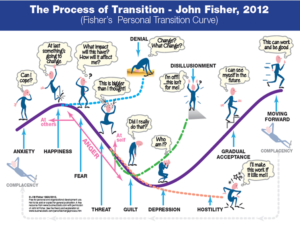Emotions in the Process of Change: How to Help Your Team Adapt? A Practical Guide for Managers
Leading a team through change is one of the greatest challenges in team management. Recently, I spoke with a Sales Director from a large corporation who encountered resistance and negativity from her team when implementing changes. Although the solutions were objectively beneficial, her team’s reaction surprised and worried her. Her experience, along with my own reflections and insights on this topic, inspired me to write this article to help other leaders effectively manage team emotions during difficult transitions.
Why Do Changes Trigger Emotions and Resistance?
In the business world, changes are inevitable. Organizations must evolve to meet shifting market conditions, customer needs, or technological progress. New solutions can bring significant benefits, such as increased efficiency, time savings, or improved work comfort. Yet, employees often respond with resistance and even negative emotions.
Why does this happen? Even changes aimed at improving the situation are challenging for people. Just as in private life, when we experience major events like moving, the birth of a child, or changing jobs, similar questions, doubts, and stress arise in professional settings. Employees often wonder about the impact of new solutions on their daily work: Will I cope with the new requirements? Is my position secure?
Natural Resistance to Change
Resistance to change is a natural reaction. People crave stability, predictability, and control in their daily work. Even when the current processes or systems aren’t perfect, they are familiar and comfortable. Change disrupts this stability and introduces uncertainty, which can trigger fear of the unknown.
Importantly, this resistance is rarely a result of a lack of professionalism. Instead, it stems from a natural desire to protect what is familiar and understood. As a manager, recognizing this helps you respond with empathy and guide your team through the transition more effectively.
Emotional Stages of Team Adaptation to Change
When facing change, employees typically move through different emotional stages before fully accepting the new situation. Understanding these stages will enable managers to provide timely and appropriate support, helping the team adapt more smoothly. Keep in mind that these phases aren’t linear—people may move back and forth between them depending on their individual circumstances.
1. Shock and Denial
The initial reaction to change may be surprise or denial. Employees may think:
- “This must be a joke.”
- “This idea will never work here.”
When changes are unexpected or poorly communicated, the team’s emotions may escalate, leading to frustration or confusion. Managers observing these reactions should remember that this is a natural part of the process, not a reflection of the team’s loyalty or competence.
2. Anger and Frustration
As employees begin to realize the change is inevitable, negative emotions like anger or frustration often surface. They may question decisions and voice doubts:
- “Why weren’t we consulted?”
- “Everything was fine—why are we changing this?”
At this stage, team members might look for arguments to justify their resistance, such as:
- “We don’t have time for this training.”
- “It’s only going to create more problems.”
It’s crucial that managers do not take these emotions personally and respond with patience. They should create space for open conversation, listen to team concerns, and remind them of the change’s objectives.
3. Analysis and Searching for Meaning
Once initial emotions subside, employees often start analyzing the situation more rationally. This is when they begin asking themselves:
- “Maybe this change does have some benefits?”
- “Could this actually improve my work?
The team may begin to notice some positive aspects of the change, even if they still approach them cautiously. This is the moment when managers should provide specific information, data, or examples justifying the transformation. Encouraging open dialogue and jointly searching for solutions is also essential.
4. Acceptance and Exploration of New Possibilities
In this final stage, employees begin to accept the change. Emotions stabilize, and the team starts to recognize tangible benefits. This is the moment when team members are likely to:
- Test new tools and solutions.
- Acquire new skills.
- Explore opportunities for further improvement.
At this stage, it is essential to reinforce positive attitudes, celebrate successes, and share the positive effects of the change.

Source: John Fisher’s model of personal change – The Personal Transition Curve
How Can Managers Help Teams Navigate Change? Practical Tips
Every employee experiences change at their own pace. While some may move quickly through the stages, others might revisit earlier phases. As a manager, your role is to provide tailored support that reduces tension, fosters trust, and helps your team embrace the new reality.
1. In the Shock and Denial Phase – Provide Clear and Reassuring Communication
The initial reactions to change are often surprise or denial. At this stage, it’s critical to clearly explain the reasons behind the change while showing empathy and addressing questions. Here’s how you can help:
- Acknowledge emotions: “I understand that this may feel surprising or even unsettling.”
- Clarify goals: “Our aim is to make work more efficient and simplify daily tasks for everyone.”
- Offer reassurance: “I’m here to guide us through this together. If you have concerns, let’s discuss them openly.”
A calm and open approach helps your team perceive the change as a deliberate and positive step toward organizational growth, rather than as a disruption or threat.
2. In the Anger and Frustration Phase – Listen and Address Concerns
At this stage, employees may express dissatisfaction, anger, or doubts. It’s essential to recognize these emotions as a natural part of the adaptation process and create a space for honest conversations. Here’s how to navigate this phase:
- Listen actively: Allow team members to voice their frustrations without interruptions or judgments.
- Respond with empathy and facts: “I hear your concerns. Yes, this will take some effort, but in the long run, it can significantly streamline our work.”
- Avoid defensiveness: Focus on collaborating to find solutions rather than justifying the change.
Demonstrating patience and understanding builds trust, eases tensions, and creates an environment where employees feel heard and supported.
3. In the Analysis and Searching for Meaning Phase – Provide Clarity and Foster Dialogue
As emotions settle, employees begin to approach the change with a more analytical mindset. This is the ideal time to address their questions and show the tangible benefits of the change. Here’s how you can encourage engagement:
- Show specific benefits: “With this new system, we can reduce project timelines by 20%.”
- Encourage collaborative dialogue: “What can we do together to make this process smoother for everyone?”
- Provide educational resources: Offer workshops, guides, or hands-on training to help your team feel equipped to handle new tools or processes.
Highlighting the positive outcomes of the change and involving the team in discussions fosters ownership and increases their commitment to the transformation.
4. In the Acceptance and Exploration Phase – Reinforce Positivity and Inspire Growth
At this final stage, employees start recognizing the value of the change and may even explore additional opportunities for improvement. Your focus here should be on sustaining momentum and encouraging innovation. Here’s what you can do:
- Celebrate progress: “Great work with adapting to the new system—it’s already making a difference!”
- Share successes: “Thanks to this change, our response time to clients has improved significantly, and their feedback has been very positive.”
- Promote innovation: “Do you see any other areas where we could make similar improvements or adjustments?”
Acknowledging the team’s efforts and emphasizing the positive impact of their work motivates them to see change as an opportunity rather than a challenge.
Summary
Understanding the emotional journey your team goes through during a period of change allows you to provide the right kind of support at the right time. Resistance to change isn’t a sign of negativity—it’s a response to uncertainty. By practicing empathetic communication, gradually implementing adjustments, involving your team in the process, and celebrating their efforts, you can transform challenges into opportunities for growth.
Well-managed change does more than improve efficiency. It strengthens trust, deepens relationships between managers and employees, and fosters a culture of adaptability. What begins as a challenge can ultimately become a stepping stone toward greater success and a higher quality of work.
Ewa Borek
Sources:
- https://www.businessballs.com/change-management/personal-change-stages-john-fisher/
- https://wroclawpsychoterapia.com/przejsc-przez-zmiane/
It can be also interesting for you We all need to get better at time management

